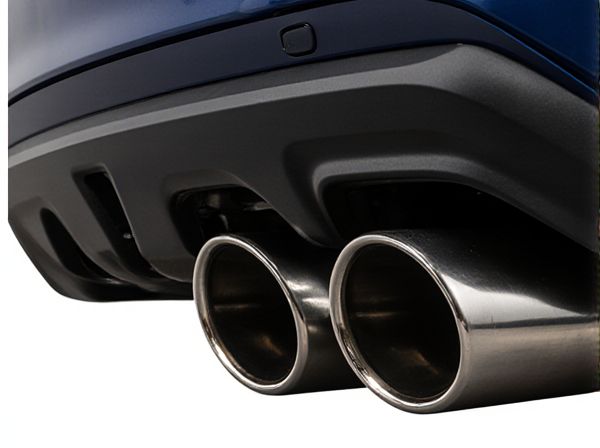
Photo illustration: Dual Exhaust vs Single Exhaust
Choosing between dual exhaust and single exhaust systems impacts your vehicle's performance and sound quality. Dual exhaust systems generally improve engine efficiency by allowing exhaust gases to exit more freely, enhancing horsepower and fuel economy. Your preference for a sportier sound and performance boost may make dual exhaust the better option compared to the simpler, often quieter single exhaust setup.
Table of Comparison
| Feature | Dual Exhaust | Single Exhaust |
|---|---|---|
| Performance | Improves engine efficiency and horsepower by allowing better exhaust flow. | Standard flow, adequate for most vehicles, less performance boost. |
| Sound | Produces a louder, sportier exhaust note. | Softer, quieter exhaust sound. |
| Fuel Efficiency | Can enhance fuel efficiency due to improved engine breathing. | Typically no significant impact on fuel consumption. |
| Cost | Higher installation and maintenance costs. | Lower cost, easier to maintain. |
| Weight | Adds extra weight due to additional components. | Lighter system overall. |
| Appearance | Provides sportier and more aggressive look. | Simple and traditional exhaust design. |
Introduction to Dual vs Single Exhaust Systems
Dual exhaust systems feature two separate exhaust pipes that improve engine efficiency by allowing gases to exit faster, resulting in better performance and a deeper sound. Single exhaust systems use one pipe to channel exhaust gases, providing a simpler, more cost-effective design that suits most everyday vehicles. Comparing flow rate, backpressure, and sound characteristics highlights the key differences between dual and single exhaust configurations.
Key Differences Between Dual and Single Exhaust
Dual exhaust systems feature two separate exhaust pipes, providing improved engine breathing and increased horsepower compared to single exhaust systems, which have only one pipe. The dual setup enhances exhaust flow efficiency, reducing backpressure and contributing to better fuel economy and performance. Single exhaust systems are typically lighter and less expensive, making them suitable for standard vehicles prioritizing cost and simplicity.
Performance Impact: Dual vs Single Exhaust
Dual exhaust systems improve engine performance by reducing backpressure and increasing exhaust gas flow, which enhances horsepower and torque. Single exhaust systems typically offer less efficient expulsion of exhaust gases, limiting engine breathing and overall power output. Vehicles with dual exhausts often experience better throttle response and fuel efficiency due to optimized exhaust scavenging and improved engine dynamics.
Fuel Efficiency Considerations
Dual exhaust systems typically improve engine efficiency by allowing exhaust gases to exit more freely, reducing backpressure and enhancing fuel combustion, which can lead to better fuel economy in performance-oriented vehicles. Single exhaust systems are generally simpler and lighter, often providing sufficient fuel efficiency for everyday driving without the added weight and complexity of dual setups. When prioritizing fuel efficiency, the specific engine design and driving conditions play crucial roles in determining whether dual or single exhaust systems offer tangible benefits.
Cost Comparison: Installation and Maintenance
Dual exhaust systems typically incur higher installation costs, ranging from $1,200 to $2,500, compared to single exhaust setups which usually cost between $400 and $1,200. Maintenance expenses for dual exhausts are also increased due to the complexity and extra components, such as additional mufflers and piping, which can lead to more frequent repairs and part replacements. Single exhaust systems generally offer lower long-term upkeep costs, making them a budget-friendly option for many vehicle owners.
Sound and Aesthetics
Dual exhaust systems deliver a deeper, more aggressive engine sound by allowing gases to exit more freely, enhancing the vehicle's auditory performance. Visually, dual exhausts create a balanced and sporty appearance, often associated with high-performance cars, while single exhausts offer a simpler, more understated look. The choice between them depends on desired sound intensity and aesthetic preference, with dual exhausts favored for their dynamic presence and acoustic impact.
Vehicle Compatibility and Suitability
Dual exhaust systems are typically compatible with high-performance or larger vehicles that require enhanced engine breathing for increased power and efficiency. Single exhaust setups are more suitable for smaller, economy-focused vehicles where simplicity, cost-effectiveness, and fuel efficiency are prioritized. Vehicle compatibility depends on engine size, exhaust flow requirements, and intended performance goals, making dual exhausts ideal for V6 and V8 engines, while single exhausts suffice for four-cylinder models.
Environmental Impact of Exhaust Choices
Dual exhaust systems typically increase engine efficiency by improving exhaust flow, which can reduce fuel consumption and lower greenhouse gas emissions compared to single exhaust setups. However, the environmental benefits depend on factors such as vehicle type, engine tuning, and emission control technologies integrated within the exhaust system. Single exhaust systems may produce higher levels of pollutants due to restricted exhaust flow, leading to less efficient combustion and increased carbon monoxide, hydrocarbons, and nitrogen oxide emissions.
Pros and Cons of Dual Exhaust Systems
Dual exhaust systems improve engine efficiency and performance by allowing exhaust gases to exit more freely, resulting in increased horsepower and better fuel economy. They tend to produce a louder, sportier sound that appeals to car enthusiasts but may cause noise disturbances in residential areas. However, dual exhaust systems are generally more expensive to install and maintain compared to single exhaust setups, adding weight and complexity to the vehicle's exhaust architecture.
Pros and Cons of Single Exhaust Systems
Single exhaust systems offer benefits such as lower initial cost, simpler installation, and reduced weight, which can improve fuel efficiency. However, single exhausts may limit engine performance by restricting exhaust flow, leading to less horsepower and torque compared to dual exhaust setups. They are generally quieter but less efficient at handling high-performance needs in larger or turbocharged engines.
 caratoz.com
caratoz.com